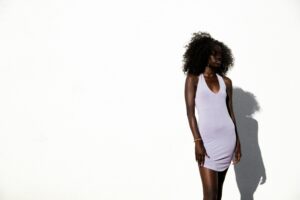
Hello Lovely, I’ve lived within a rich cultural tapestry that holds its own distinct view of beauty. In my community, the preferred female form diverges significantly from the svelte figures lauded on Western fashion runways. This divergence is rooted in a deep cultural narrative that values heritage and aesthetics in a way that distinctly shapes the female identity. Here’s my personal reflection on the insights into the preferred female form in Black culture, and the journey that comes with it.
In my community, curves are not just preferred; they are celebrated. This is a preference etched deep in our cultural history and aesthetics, intertwining femininity, fertility, and health with a fuller body type. We turn away from the slender silhouettes of Western fashion, finding beauty instead in the ampleness of form. Our music, art, and media uplift these curvaceous figures, creating a cultural echo chamber where fullness is glorified.

In Black culture, people often celebrate curvier figures, which can challenge naturally slim women. The preferred female form emphasizes fuller hips, thighs, and a defined waist, putting pressure on slim women to conform to these ideals and potentially leading to body image struggles. Although body diversity is gaining recognition, the cultural preference for curvier shapes can make it hard for slim women to feel accepted. To overcome these challenges and celebrate all body types, embracing body positivity is essential.
Tradition, media, and societal norms have long influenced the preferred female form in Black culture. People often admire fuller, curvier figures, seeing them as symbols of strength and fertility. However, the cultural pressure to fit these beauty standards can be overwhelming. Many women feel the need to conform to a particular body shape, driven by societal expectations and media portrayals. Yet, it’s important to recognize self-worth beyond physical appearance. Navigating between personal choice and cultural ideals is a challenge, but women should define their own beauty and identity without feeling confined by external pressures.
In Black culture, people highly celebrate the curvy female form, viewing it as a symbol of beauty, strength, and femininity. This preference for fuller figures traces back to historical roots, often linking them to prosperity, health, and abundance. Music, fashion, and media consistently elevate curvier body types, reinforcing their cultural importance. Unlike mainstream standards, Black communities see curves as a unique expression of pride and resilience. This enduring appreciation highlights how cultural beauty ideals focus on curves, which remain central to representing femininity and empowerment.

For women like me, our navigation of body image and cultural identity is a complex dance. It’s about reconciling the love for one’s natural body with external pressures and ideals. It’s also about recognizing these ideals as part of a cultural narrative that honours certain attributes as symbols of beauty and strength. The challenge lies in fostering self-love in an environment that doesn’t always celebrate our natural form.
My path to self-acceptance has required me to see the beauty in diversity and affirm the worth of my own unique form. It has demanded a critical look at ingrained beauty standards and an understanding that these should not dictate my value. Advocating for body positivity and inclusivity within my culture is key in reshaping perceptions and broadening the scope of beauty to be more encompassing.
Media and representation have immense power in defining and challenging beauty standards. By promoting visibility for all body types in media and entertainment, we chip away at the monolithic standards of beauty and celebrate a wider spectrum of forms. This representation is a powerful tool that encourages women to embrace their natural bodies and advocates for a more inclusive and accepting standard of beauty.
In a culture where we deeply interweave the celebration of curves with our heritage and aesthetic values, the movement toward inclusivity and body positivity becomes more important than ever. Women like me, navigating the complex waters of preferred beauty standards, face a journey filled with both challenges and opportunities for growth. By embracing diversity and fostering a deeper, more comprehensive appreciation of beauty, we honour our culture while cherishing the unique beauty of every woman, regardless of her shape.
Wishing you peace of mind
Samanthia
4-minute read Have you ever found yourself lying awake at night, heart heavy with worry about your teenager’s safety during interactions with the police? It’s a question that lingers for many parents and caregivers, especially when history and statistics both
4-minute read I’ve spent a lot of time thinking about beauty—what it means, who gets to define it, and whether it’s really as inclusive as we like to think. And the more I look at it, the more I realize
4-minute read Let’s be honest—the Hidden Agenda Behind Beauty Ads is everywhere. They follow us on our phones, pop up in our social feeds, and even sneak their way into our subconscious when we least expect it. One minute you’re